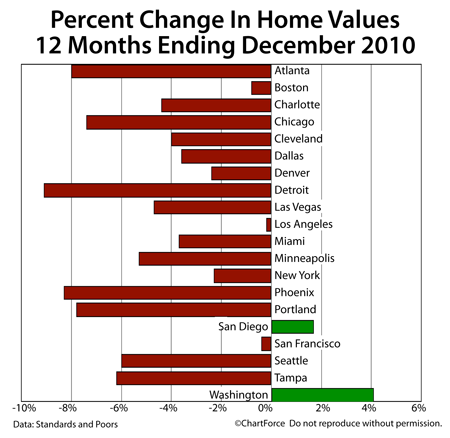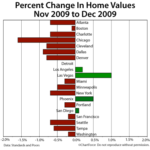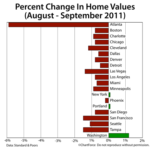
Why Case Schiller is a Waste of Your Time
Last week, Standard & Poor’s released its Case-Shiller Index for December 2010. The index is a home valuation tracker, meant to measure the change in home prices from one period to the next.
December’s Case-Shiller Index showed major devaluations nationwide. As compared to December 2009, on a year-over-year basis, home values fell in 18 of the Case Shiller Index’s 20 tracked markets, and the U.S. National Index dropped 4% overall.
The retreat puts December’s home values at similar levels as compared to early-2003. Good? I guess it depends on your prospective.
With that said, buyers and sellers in the Des Moines area would be wise to take the findings lightly. The Case-Shiller Index is inherently flawed. As such, its results are neither practical — nor relevant — to everyday Americans.
In fact, there are 3 Case-Shiller flaws.
The first flaw is the index’s limited sample set. Wikipedia lists 3,100+ municipalities nationwide and we can be certain that real estate is bought and sold in all of them. The Case-Shiller Index, however, measures just 20 of them. That’s less than 1% of all U.S. cities. And then, within those tracked cities, Case-Shiller reports an average, lumping disparate neighborhoods and streets into one big number. Guess who’s not included? That’s right, Des Moines. Actually, no cities in Iowa are!
It’s All In The Words
The second Case-Shiller Index flaw is how it measures home value changes. The index only consider at “repeat sales” of the same home, so long as that home is a single-family, detached property. Condominiums, multi-family homes, and new construction are ignored in the Case-Shiller Index.
Because distressed properties account for such a high percentage of resales lately — 36% in December –foreclosures and short sales skew Case-Shiller Index even worse.
And, lastly, the Case-Shiller Index is flawed by “age”. Because it reports closed sales a 60-day delay, December’s Case-Shiller Index is measuring the values of home sales contracts from September and October. The Case-Shiller Index, therefore, is a snapshot of the not-so-recent past, and does little to tell us about the next 60 days.
Overall, the Case-Shiller Index is helpful tool for economists and policy-makers, but it doesn’t do much good for individual homeowners across the city of Ankeny or anywhere else. For accurate, real-time housing data in your local market, talk to a real estate professional instead. If you need that type of assistance, you’re in the right spot. I’d be happy to connect you with a local Realtor to research home prices in your area. Just send me a message or give me a phone call (all of my information is on the side bar) and I can set you up with the right person!









